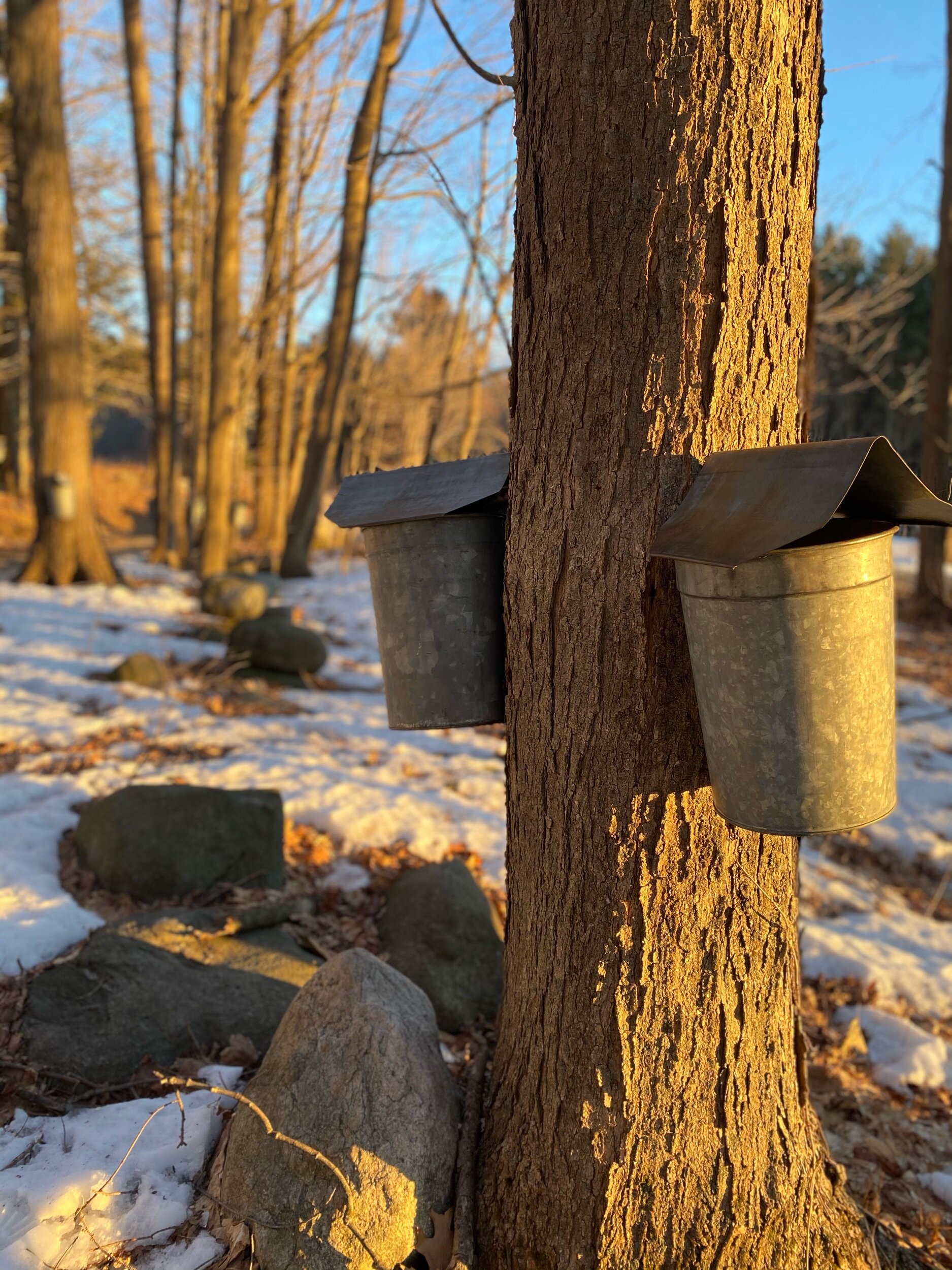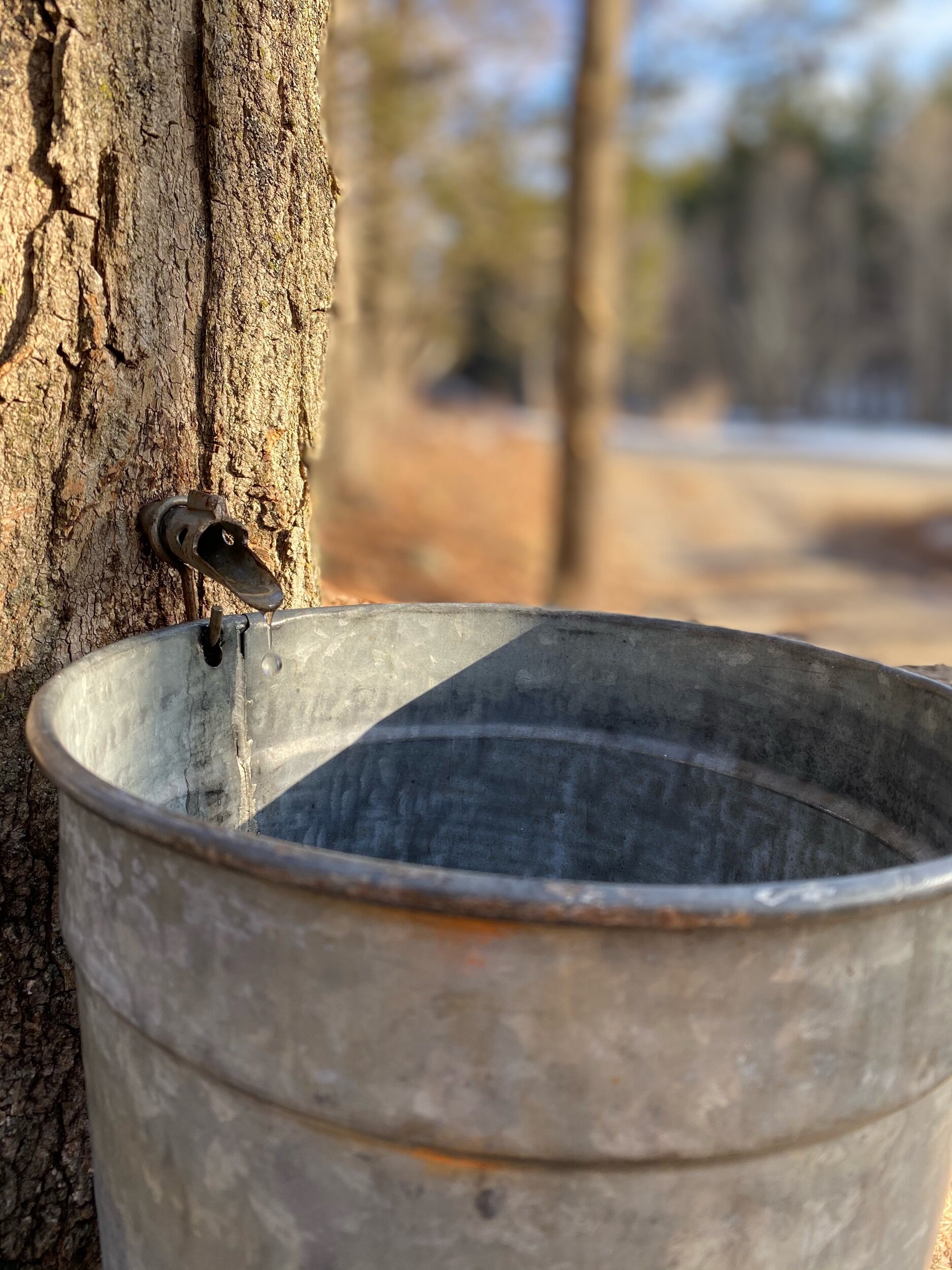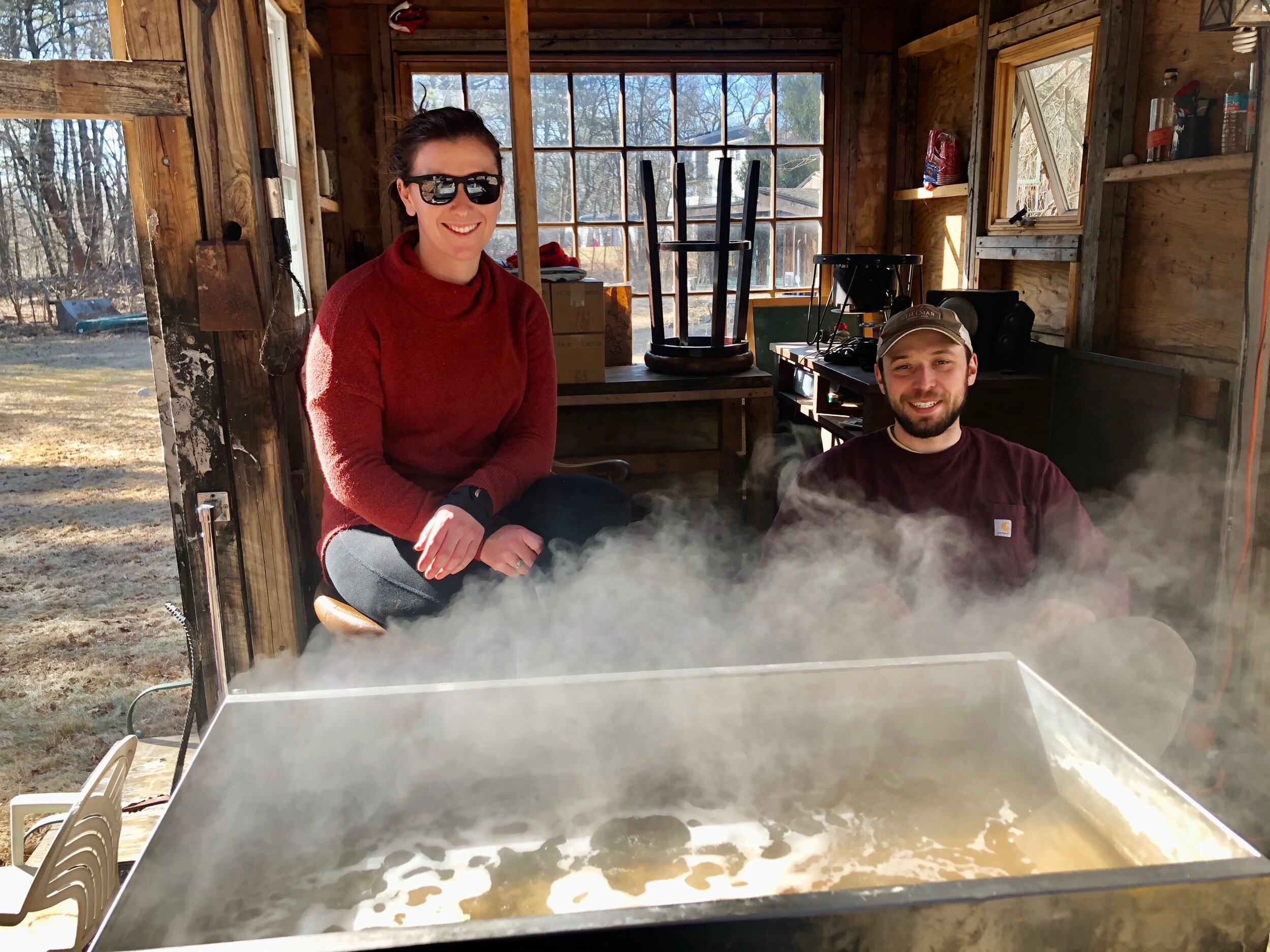One sure sign that spring is near is the sight of sap buckets (or plastic tubes, as is now common) hanging from maple trees across New England. When temps get warm during the day but stay below freezing at night, it’s the ideal time to tap trees and collect their sweet sap. But for sap to get from a tree to the delicious syrup on our pancakes is not a simple task…
Sap buckets, February 2021.
Sap dripping from the spile into a bucket.
History
Maple sap was collected by Native Americans as early as 1609. When spring was near, tribes would move to an area of forest that was abundant in sugar maples, establishing “sugar camps” for the few weeks that sap flowed. They would slash “V”s into tree trunks and collect the sap in vessels made of hollowed out logs or clay. Before the time of metal pots, Native Americans would then boil away the sap by dropping hot rocks into the vessels. Back then, there wasn’t an efficient way to store syrup, so they boiled the sap all the way down to dry maple sugar that could easily be stored and saved for use throughout the year.
Production evolved much over the continuing centuries, and eventually “spiles” were used instead of making slashes on the trees. Metal tanks became available for storage, and sap was heated over fires or stoves to evaporate more quickly. Buildings were erected to boil down sap undercover, giving way to the quintessential “sugarhouses” that are still a mainstay in the yearly tradition of maple sugaring.
Sugar Maple Trees
Temperature is the key component for active sap flow. A rise in temperature of the sapwood to above freezing causes a positive pressure within the wood, inducing sap flow. On warm late-winter days which follow cold nights, sap can flow down from the branches and then out a spout drilled into the tree. The sap can also flows back and forth laterally within the tree. It will flow out a “tap” or through a broken or cut branch. The internal pressure of the tree, when it is greater than the atmospheric pressure, causes the sap to flow out, just like how blood flows out of a wound.
The period of sap flow can vary from just a few hours to a few days on end. Many environmental factors and tree metabolic factors affect the length of sap flow period and the amount of sap produced. For strong sap flows to be repeated, a suitable temperature cycle above and below freezing must occur to allow strong positive sap pressure to develop. The sap flow ceases entirely when these temperature cycles cease to exist.
An abundant sap years also depends on the weather conditions of the previous summer to store as much carbohydrates as possible in the form of starch. These stored starch reserves convert to sucrose and are dissolved in the sap as spring approaches. The amount of sugar (sucrose) in the springtime sap depends on many factors including tree genetics, leaf mass, site conditions, amount of sun the previous growing season and overall tree health.
** Fun Fact: While the general rule of thumb is that it takes 40 gallons of sap to make 1 gallon of sugar, the ratio of the trees on our farm (as well as that of the family who taps our trees), is about 36:1. The Roseberry family, who taps our trees, have always believed that that’s due to both farms being long-time dairies with plenty of cow manure to provide nutrients to the maple trees. :-) **
Maple trees in autumn at Maplebrook Farm
Maple Syrup Production
When “sap season” has arrived, one must tap the trees. This involves drilling holes about two inches deep into the sapwood of a tree, and tapping a “spile” into the hole that will funnel the sap outward. In the “old-fashioned” bucket method, a metal bucket with lid is hung from a hook on the spile to collect the sap. Nowadays, many people use plastic tubing to collect sap, which is more time and labor efficient. In this method, a plastic spout that is connected to a pipeline system is tapped into the tree and allows the sap from multiple taps and trees to all flow into one central vessel.
A maple tree must be a least 10 inches in diameter and in good health before it can be tapped. It usually takes about forty years before a tree will reach tappable size. The hole is usually placed about waist high on the tree, not below any dead limbs, and not near previous tapholes. Larger trees may take as many as three or four taps, but only if they are healthy. If proper tapping procedures are followed, tapping will not endanger the health and vitality of the tree. A healthy sugar maple can provide sap every year for a hundred years or more.
Throughout the 4–6 week sugar season, each tap hole will yield approximately ten gallons of sap. This is only a small portion of the tree’s total sap production and will not hurt the tree. This amount vary greatly from year to year, and depend upon the length of the season, the sweetness of the sap, and many complex conditions of nature, such as weather conditions, soil, tree genetics, and tree health.
Maple sap, as it comes from the tree is a clear, slightly sweet liquid (similar to maple water, which has become a popular item on the market today).
The sugar content ranges from one to four percent.
A device called a “hydrometer” can be floated in the sap to determine the exact sugar content.
Sweeter sap is favored because less water will have to be evaporated to make maple syrup.
The sap must be evaporated as soon as possible because the freshest sap makes the best quality syrup
Boiling sap is often a family or community event.
Once collected, sap is boiled down in a “sugarhouse” which can be as rustic or elaborate as once chooses. Every sugar house has an evaporator that is used to boil the sap down into syrup. A hooby sugarmaker can use a much smaller setup, and boiling down syrup on a kitchen stove is possible as well.
Evaporators are made up of one or more flat pans which sit on an “arch,” a type of firebox.
Wood, oil, gas, wood chips or wood pellets are burned at the front end, and the flames are drawn along the underside of the pan, heating and boiling the sap as they travel towards the rear.
It commonly takes about one cord of wood or sixty gallons of oil to boil down 800 gallons of sap into maple syrup.
Depending on the size of the evaporator and the number of trees tapped, this may represent anywhere from two hours to two whole days of boiling.
When the temperature of boiling sap reaches seven and a half degrees above the boiling point of water, it is at the proper density and has become maple syrup. Another way of checking for the proper density or sugar content is to place a scoop into the boiling syrup. Coming from the tree, maple sap is approximately 98% water and 2% sugar. When the syrup is finished, it is only 33% water and 67% sugar. It takes approximately 40 gallons of sap to make 1 gallon of sugar.
Now is the time to visit a local sugar shack and witness for yourself the process of boiling down sap to syrup. If nothing else, at least pick up a container of REAL maple syrup and discover the pure deliciousness of one of Nature’s best sweets.
CLICK HERE for recipes that utilize maple syrup
Photo Credit: Peter Heins, Sunny Knoll Farm
All information gathered for this article was sourced from the Massachusetts Maple Producers Association and can be found at massmaple.org.





